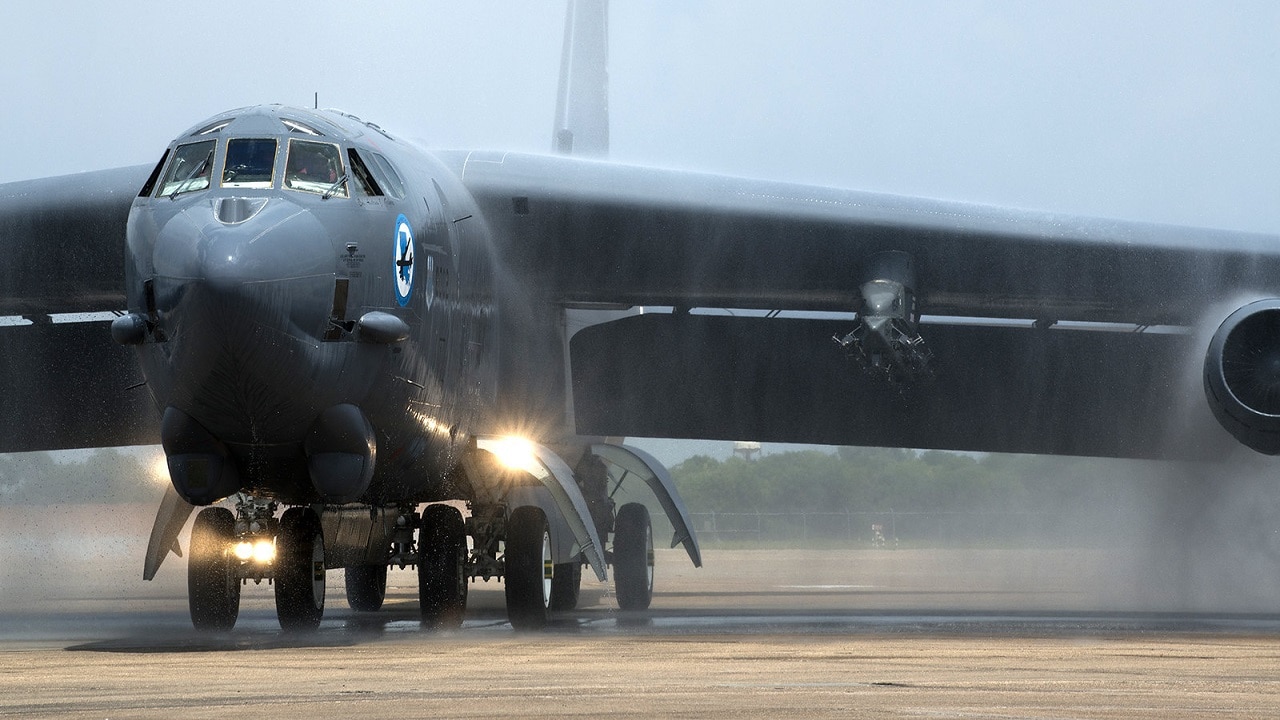The United States Air Force’s B-52 Stratofortress continues to serve as the backbone of the bomber fleet, and over its nearly seven decades in service, it has been described as almost unstoppable.
That was put to the test in a training exercise last month, and Royal Air Force (RAF) Typhoons were able to successfully intercept the Cold War long-range heavy strategic bombers, as part of a training exercise near Estonia.
The RAF has shared photos from the recent exercise, which showed how British Typhoons and French Rafale fighters were able to carry out a simulated intercept of two of the U.S. Air Force’s Bomber Task Force aircraft. The B-52 provides the U.S. with both immediate nuclear and conventional strike capabilities.
“1(F) Sqn Typhoons from 140 EAW, deployed on @NATO’s Baltic Air Policing Mission, have conducted a simulated intercept of 2x B-52 strategic bombers of the @usairforce Bomber Task Force in the skies over the Baltics, before escorting them south-southwest towards western Europe.”
1(F) Sqn Typhoons from 140 EAW, deployed on @NATO’s Baltic Air Policing Mission, have conducted a simulated intercept of 2x B-52 strategic bombers of the @usairforce Bomber Task Force in the skies over the Baltics, before escorting them south-southwest towards western Europe. pic.twitter.com/R24hYwa6on
— Royal Air Force (@RoyalAirForce) July 24, 2023
NATO’s Baltic Air Policing Mission is currently aimed at protecting the airspace of Estonia, Latvia, and Lithuania, and it has already proven to be a critical element in the alliance’s collective defense strategy.
The mission first began in 2004 when the three Baltic States joined NATO. It continues to be one of the main missions of NATO air forces, which rotate to protect Estonian, Latvian, and Lithuanian airspaces from incursions, as those countries have no airborne capability of their own.
The Air Policing Mission has been quite busy – and it was reported that jet fighters were scrambled to intercept Russian aircraft 21 times in just 21 days in June!
B-52s Logging the Miles
Earlier this month and on the other side of the world, B-52 bombers also operated alongside B-1 Lancer and B-2 Spirit bombers from an unfamiliar airfield in Alaska, as part of a rare assembly of the Air Force’s three different bombers. It also marked the first major exercise for the B-2 since a six-month, fleet-wide safety pause was lifted in May, following an aircraft mishap last December.
“The concerted effort by all the bomber Airmen is a testament to the flexibility and agility of the force to operate in unfamiliar environments,” Justin Oakes, the director of public affairs for the Eighth Air Force and Joint-Global Strike Operations Center, told Air & Space Forces Magazine.
During the July 18-19 training exercises, the three unique types of U.S. Air Force bombers operated from Joint Base Elmendorf-Richardson (JBER), Alaska, which does not normally host bomber units, and served to function as “a notional forward operating base.”
JBER served as a unique gathering, as the B-1 Lancers were deployed from Dyess Air Force Base (AFB), Texas; the B-2s from Whiteman AFB, Missouri; while the B-52s arrived from Minot AFB, N.D.
“The ability to perform training and integration exercises at a location that does not traditionally host bombers is what defines this exercise as an Agile Combat Employment mission,” added Oakes.
Once gathered at JBER, the bombers reportedly took part in fighter integration, strategic communications, and targeting exercises. Even after seven decades the B-52s continue to serve in crucial roles for the defense of the United States.
Author Experience and Expertise
A Senior Editor for 19FortyFive, Peter Suciu is a Michigan-based writer. He has contributed to more than four dozen magazines, newspapers, and websites with over 3,200 published pieces over a twenty-year career in journalism. He regularly writes about military hardware, firearms history, cybersecurity, politics, and international affairs. Peter is also a Contributing Writer for Forbes and Clearance Jobs. You can follow him on Twitter: @PeterSuciu.
From 19FortyFive

